当前位置:
X-MOL 学术
›
Macromol. Rapid Commun.
›
论文详情
Our official English website, www.x-mol.net, welcomes your
feedback! (Note: you will need to create a separate account there.)
Synthesis of Thermoplastic Poly(2-methoxyethyl acrylate)-Based Polyurethane by RAFT and Condensation Polymerization.
Macromolecular Rapid Communications ( IF 4.2 ) Pub Date : 2020-08-17 , DOI: 10.1002/marc.202000346 Shunsuke Tazawa 1 , Tomoki Maeda 1, 2 , Masamitsu Nakayama 1, 3 , Atsushi Hotta 1
Macromolecular Rapid Communications ( IF 4.2 ) Pub Date : 2020-08-17 , DOI: 10.1002/marc.202000346 Shunsuke Tazawa 1 , Tomoki Maeda 1, 2 , Masamitsu Nakayama 1, 3 , Atsushi Hotta 1
Affiliation

|
Thermoplastic solid poly(2‐methoxyethyl acrylate) (PMEA)‐based polyurethane (PU) is synthesized through the reversible addition−fragmentation chain transfer (RAFT) polymerization and the condensation polymerization, using hydroxyl‐terminated RAFT reagents and diisocyanate, respectively. Neat PMEA is a promising antithrombogenic liquid used in the medical fields. The thermoplastic property of the solid PMEA‐based PU due to hydrogen bonding is confirmed by the dynamic mechanical analysis (DMA) at temperature below 72 °C. The antithrombogenic property of PMEA‐based PU is also analyzed by the platelet adhesion test. The number of platelets on PMEA‐based PU is 17 cells per unit area, which is smaller than that on the fluorinated diamond‐like carbon (F‐DLC), a well‐known highly antithrombogenic material. It is concluded that a newly synthesized PMEA‐based PU exhibits thermoplastic characteristics with excellent antithrombogenicity.
中文翻译:

RAFT和缩聚反应合成热塑性聚(丙烯酸2-甲氧基乙酯)基聚氨酯。
通过可逆的加成-断裂链转移(RAFT)聚合和缩聚反应,分别使用羟基封端的RAFT试剂和二异氰酸酯合成热塑性固体聚丙烯酸2-甲氧基乙酯(PMEA)基聚氨酯(PU)。整洁的PMEA是一种有前途的抗血栓形成液体,用于医疗领域。在低于72°C的温度下通过动态力学分析(DMA)证实了由于氢键作用导致的基于PMEA的固体PU的热塑性。还通过血小板粘附试验分析了基于PMEA的PU的抗血栓形成特性。基于PMEA的PU上的血小板数量为每单位面积17个细胞,这比众所周知的高度抗血栓形成材料氟化类金刚石碳(F-DLC)的血小板小。
更新日期:2020-10-05
中文翻译:

RAFT和缩聚反应合成热塑性聚(丙烯酸2-甲氧基乙酯)基聚氨酯。
通过可逆的加成-断裂链转移(RAFT)聚合和缩聚反应,分别使用羟基封端的RAFT试剂和二异氰酸酯合成热塑性固体聚丙烯酸2-甲氧基乙酯(PMEA)基聚氨酯(PU)。整洁的PMEA是一种有前途的抗血栓形成液体,用于医疗领域。在低于72°C的温度下通过动态力学分析(DMA)证实了由于氢键作用导致的基于PMEA的固体PU的热塑性。还通过血小板粘附试验分析了基于PMEA的PU的抗血栓形成特性。基于PMEA的PU上的血小板数量为每单位面积17个细胞,这比众所周知的高度抗血栓形成材料氟化类金刚石碳(F-DLC)的血小板小。











































 京公网安备 11010802027423号
京公网安备 11010802027423号